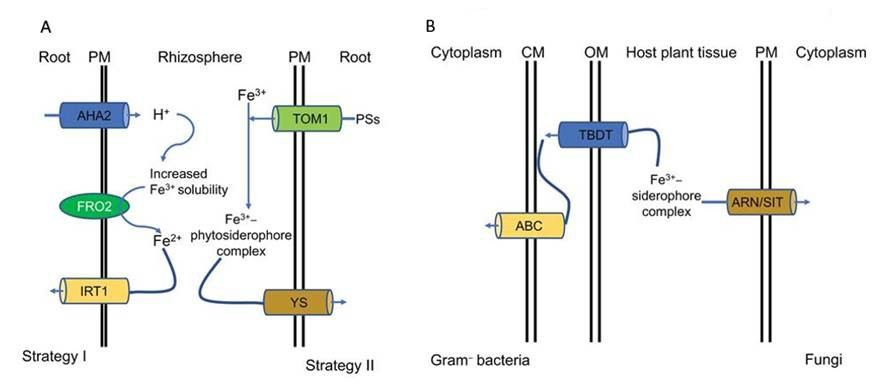Lifeasible specializes in plant protection and offers services to help study plant-pathogen interactions. Here we provide services to study the role of iron in plant-pathogen interactions.
The homeostasis of iron is essential for organisms. Iron (Fe) is a micronutrient for organisms, including plants and their pathogenic microorganisms. In plants, iron is essential for hormone synthesis and photosynthesis. In pathogenic microorganisms, iron is necessary for them to infect host plants and proliferate within the host plant. Physiological excess iron can produce hydroxyl radicals through the Fenton reaction, which can oxidatively damage substances such as lipids, proteins, and DNA. The uptake (Fig. 1), transport, storage, and regulation of iron by plants and pathogenic organisms influence the interaction between plants and pathogens. Studying the mechanisms of iron-related interactions between plants and pathogens can help develop new methods of plant protection.
 Fig. 1 Iron uptake strategies in plants (A) and the Fe3+-siderophore complex uptake system in plant pathogens (B) (Liu et al., 2021).
Fig. 1 Iron uptake strategies in plants (A) and the Fe3+-siderophore complex uptake system in plant pathogens (B) (Liu et al., 2021).
Lifeasible offers services to help study iron-related interactions between plants and pathogens, including the study of genes associated with iron homeostasis in plants or pathogens, plant iron regulation strategies to immunize against pathogens, and iron uptake strategies used by pathogens to infect host plants.
Study of genes associated with plant iron homeostasis
Understanding plant iron homeostasis mechanisms is fundamental to studying plant iron distribution strategies against pathogenic pathogens. We offer services to help study the complex system of iron homeostasis regulation that exists in plants. Gramineae and non-Gramineae vary in their iron homeostasis. We help study the role of potential iron homeostasis-related genes individually and their interactions with other iron homeostasis-related proteins or genes.
Study of genes associated with pathogen iron homeostasis
Iron uptake is essential for pathogenic organisms to exert their virulence, especially bacterial pathogens. We help investigate the different iron uptake strategies of pathogens and the associated genes that regulate iron homeostasis. We help investigate multiple iron uptake systems, including high-affinity uptake pathways (siderophore-based and reductive iron assimilation (RIA)-based iron uptake pathways) and low-affinity uptake pathways (iron-containing protein uptake and ferrous iron uptake). We help to detect the impact of potential iron homeostasis-related genes on iron uptake by pathogens.
Plant iron regulation strategies to immunize against pathogens
Plant immunity to pathogens is correlated with the iron status of the host plant. We help study the iron regulation strategies of host plants in response to pathogen infection, including iron overaccumulation at the infection site and depriving iron uptake of the pathogen. We help detect the redistribution of iron in plants at the intracellular level and the intercellular level. In addition, we also help analyze the role of different plant iron homeostasis-related genes in resistance to pathogen invasion.
Iron uptake strategies used by pathogens to infect host plants
The uptake of iron in plants by pathogens influences their virulence. We help systematically assess the pathogenesis of mutants with a single iron uptake system to help elucidate the contribution of each iron uptake pathway to pathogen virulence. We help investigate the effect of a single iron regulatory factor on pathogenic bacteria pathogenicity.
Lifeasible fully understands the mechanisms of iron homeostasis in plants and pathogens and has expertise in studying iron homeostasis, regulation, and distribution. We can achieve efficient detection of iron status and factors influencing iron status in plant-pathogen interactions. Please contact us for our professional services.
References
Lifeasible has established a one-stop service platform for plants. In addition to obtaining customized solutions for plant genetic engineering, customers can also conduct follow-up analysis and research on plants through our analysis platform. The analytical services we provide include but are not limited to the following:
STU-CRISPR System Improves Plant Genome Editing Efficiency
April 19, 2024
Application of Exosomes in Facial Beauty
April 12, 2024